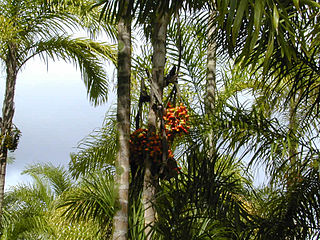
Bactris is a genus of spiny palms which are native to Mexico, South and Central America and the Caribbean. Most species are small trees about 2 m tall, but some are large trees while others are shrubs with subterranean stems. They have simple or pinnately compound leaves and yellow, orange, red or purple-black fruit. The genus is most closely related to several other spiny palms—Acrocomia, Aiphanes, Astrocaryum and Desmoncus. The fruit of several species is edible, most notably B. gasipaes, while others are used medicinally or for construction.

Butia is a genus of palms in the family Arecaceae, native to the South American countries of Brazil, Paraguay, Uruguay and Argentina. Many species produce edible fruits, which are sometimes used to make alcoholic beverages and other foods. The name is derived from a Brazilian vernacular word for members of the genus.
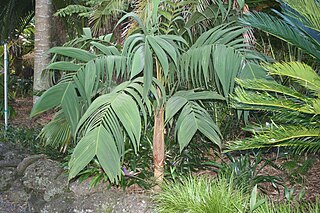
Geonoma is a genus of small to medium-sized palms native to the forest understorey of tropical Central and South America.
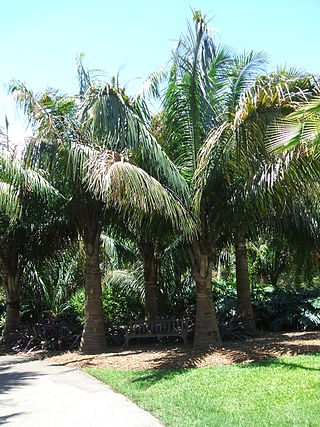
Attalea crassispatha is a palm which is endemic to southwest Haiti. The most geographically isolated member of the genus, it is considered a critically endangered species and has been called one of the rarest palms in the Americas.

Attalea is a large genus of palms native to Mexico, the Caribbean, Central and South America. This pinnately-leaved, non-spiny genus includes both small palms lacking an aboveground stem and large trees. The genus has a complicated taxonomic history, and has often been split into four or five genera based on differences in the male flowers. Since the genera can only be distinguished on the basis of their male flowers, the existence of intermediate flower types and the existence of hybrids between different genera has been used as an argument for keeping them all in the same genus. This has been supported by recent molecular phylogenies.

Butia eriospatha is a small species of Butia palm endemic to the highlands of southern Brazil. It is very similar to B. odorata, but is easily distinguished from this species by the distinct spathes which are densely covered in rust-coloured, woolly hairs. Indeed, the specific epithet is derived from Greek ἔριον, wool, and Latin spatha, which refers to the spathe. It has been given the name woolly jelly palm (UK) or wooly jelly palm (US) in English. Vernacular names for it where it is native are butiá-da-serra, butiázeiro, butiá-veludo, butiábutiá verdadeiro, butiá-do-campo, yatáy and macumá.
Syagrus macrocarpa is a rare species of palm found only as scattered isolated individuals and small groups in the east of the Brazilian states of Espírito Santo, Minas Gerais and Rio de Janeiro. It grows to 4-10m tall, with 8-20 leaves to 2m long. The leaves are bent at the end, with very hairy margins near the trunk, and consist of 180-320 slightly coiled leaflets irregularly arranged in several planes on the rake. The fruit are oval, greenish-yellow, 6–9 cm long. It is grown in cultivation. Seeds are difficult to germinate, with low rates of germination. Common names for it in Minas Gerais are baba-de-boi-grande and maria-rosa.
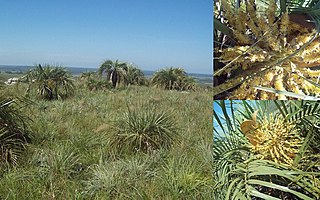
Butia paraguayensis is a species of Butia palm tree found in the cerrado region of South America. Its natural range runs from Mato Grosso do Sul and São Paulo in southern Brazil through Paraguay to northern Argentina and Uruguay. It was given the name dwarf yatay palm in English by 2000, and it is locally known as yata'i in Guaraní in Paraguay, or butiá-do-cerrado in Portuguese in Rio Grande do Sul, Brazil.

Butia capitata, also known as jelly palm, is a Butia palm native to the states of Minas Gerais and Goiás in Brazil. It is known locally as coquinho-azedo or butiá in (northern) Minas Gerais. This palm grows up to 8m. It has feather palm pinnate leaves that arch inwards towards a thick stout trunk.

Butia yatay, the jelly palm or yatay palm, is a Butia palm native to southern Brazil, Uruguay and northern Argentina. It is known as the butiá-jataí in Portuguese in the south of Brazil, as well as simply jataí or butiá. It is sometimes cultivated as an ornamental in Europe and the United States. It is the tallest of all the species in the genus Butia. The fruit is edible with a sweet flavour.
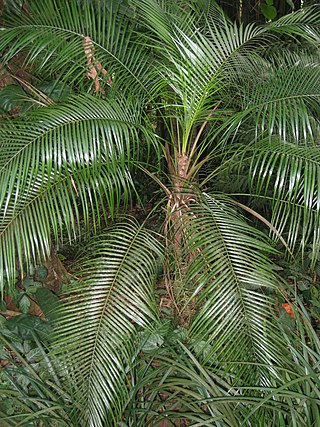
Syagrus weddelliana, also known as the miniature coconut palm or Weddell's palm, is a feather palm in the palm family.

Butia campicola is a very small species of Butia palm with an underground trunk; native to the cerrados of central Paraguay and south-central Brazil.

Butia stolonifera was an oddly growing palm assigned to the genus Butia found only once in Uruguay in the 19th century, but which now is considered to be uncertain as a valid species.
Butia microspadix is a very small species of grass-like Butia palm usually with an underground trunk; native to the states of Paraná and São Paulo in Brazil.

Butia archeri is a small species of Butia palm with a short trunk native to the states of Goiás, Brasília, Minas Gerais and São Paulo in Brazil.
Butia arenicola is a very small species of Butia palm with an underground trunk; native to Paraguay and the state of Mato Grosso do Sul in Brazil. Boquierinho is recorded as a possible local vernacular name for it.
Butia pubispatha is a very small and extremely rare species of Butia palm with an underground trunk; endemic to the east of the state of Paraná in southeastern Brazil.
Butia catarinensis is a mid-sized species of Butia palm native to the states of Rio Grande do Sul, Santa Catarina in Brazil.














